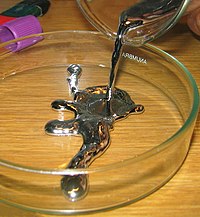
Photo from wikipedia
Supported liquid membranes have been used to implement a hollow fibre liquid-phase microextraction (HF-LPME) method for the preconcentration of Cd(II) in natural waters as a sample preparation step for its… Click to show full abstract
Supported liquid membranes have been used to implement a hollow fibre liquid-phase microextraction (HF-LPME) method for the preconcentration of Cd(II) in natural waters as a sample preparation step for its determination by high-resolution continuum source graphite furnace atomic absorption spectrometry (HR-CS-GFAAS). This system was designed to use four hollow fibres simultaneously with the same sample, thus improving the simplicity, speed and reproducibility of the results. The organic liquid membrane bis-(2,4,4-trimethylpentyl) phosphinic acid (Cyanex® 272) dissolved in dihexylether (DHE) was immobilised into the pores of the walls of polypropylene hollow fibres. After extraction, the cadmium-enriched acidic phases were recovered and analysed by triplicate. To optimise the extraction process, the effect of both physical and chemical variables was studied, and optimum results with an enrichment factor (EF) of 292 were obtained for a fibre length of 6 cm, 1.06 M Cyanex 272, 0.04 M HNO3, stirring rate of 600 rpm and an extraction time of 4.26 h. For practical applications, extraction time was reduced to 2 h, keeping the EF as high as 130. Under these conditions, a detection limit of 0.13 ng L−1 Cd(II) was obtained, with a reproducibility of 3.3 % and a linear range up to 3 µg L−1 being achieved. The proposed method was successfully applied to the determination of cadmium in mineral, tap and seawater samples.
Journal Title: Membranes
Year Published: 2023
Link to full text (if available)
Share on Social Media: Sign Up to like & get
recommendations!